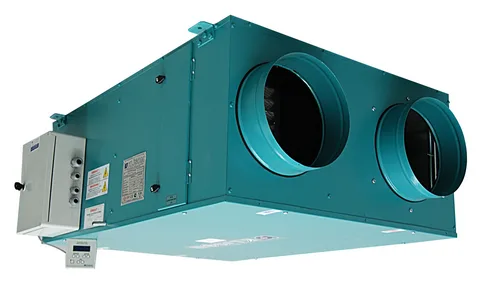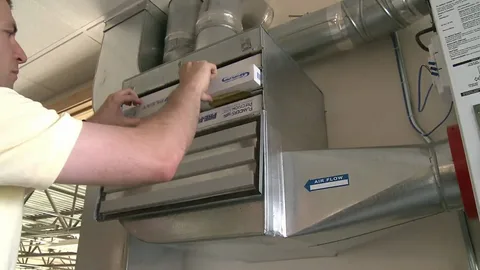Are you tired of constantly adjusting the thermostat to maintain a comfortable temperature in your home? Are you concerned about rising energy bills and the environmental impact of excessive heating and cooling? If so, it’s time to consider investing in a heat recovery ventilator (hrv). That innovative system not only helps regulate the temperature in your home but also improves air quality and reduces energy consumption. In that blog post, they will discuss the benefits of having an Hrv heating in your home and why it’s a smart choice for homeowners looking to save money and improve their indoor air quality.
Understanding The Functioning
If you’re not familiar with how a heat recovery ventilator (hrv) works, let’s break it down for you. An hrv is a ventilation system that exchanges stale indoor air with fresh outdoor air while also transferring heat from the outgoing air to the incoming air. That allows for efficient energy use and temperature regulation in your home.
Here’s how it works: the hrv consists of two separate ventilation systems – one for incoming air and one for outgoing air. These systems are connected by a heat exchanger, which is the key component of the hrv. As stale indoor air is expelled from your home, it passes through one side of the heat exchanger, while fresh outdoor air is drawn in through the other side
 Magic Behind Hrv Heat Transfer System
Magic Behind Hrv Heat Transfer System
Have you ever wondered how a heat recovery ventilator (hrv) is able to transfer heat from outgoing air to incoming air? It may seem like magic, but it’s actually a clever and efficient process.
The secret lies in the Hrv heat transfer system, the key component of the hrv system. As stale indoor air is expelled from your home, it passes through one side of the heat exchanger, while fresh outdoor air is drawn in through the other side. The heat exchanger is designed to transfer the heat from the outgoing air to the incoming air without the two streams of air mixing.
The heat transfer occurs through a process called thermal conduction. The heat from the warmer outgoing air is conducted through the walls of the heat exchanger and is absorbed by the cooler incoming air. That ensures that you don’t lose valuable heat from your home while still bringing in fresh outdoor air.
Benefits Of Heat Exchanger
The benefits of having an heat exchanger in your home are numerous and can greatly improve your overall living experience. Firstly, an heat exchanger helps regulate the temperature in your home, ensuring that it remains comfortable and consistent throughout the year. No more constantly adjusting the thermostat or dealing with hot and cold spots in different rooms!
In addition to temperature regulation, the heat exchanger also improves air quality. Removing pollutants, allergens, and excess humidity from your home ensures that you and your family are breathing in cleaner and healthier air. That is especially beneficial for individuals with allergies or respiratory issues.
How Does The Hrv Heat Exchanger Contribute To Efficient Energy Use?
The hrv heat exchanger plays a crucial role in contributing to efficient energy use in your home. By harnessing the heat from the outgoing air and transferring it to the incoming air, the heat exchanger ensures that valuable heat energy is not wasted. That means that your home can maintain a comfortable temperature without the need for excessive heating or cooling, ultimately reducing your energy consumption.
The key to the efficiency of the heat exchanger lies in its ability to recover and reuse the heat that would have otherwise been lost. By utilizing thermal conduction, the heat is conducted through the walls of the heat exchanger and absorbed by the cooler incoming air.
Lower Your Energy Bills
By reducing your energy consumption, the heat exchanger can also help lower your energy bills. Instead of constantly adjusting your thermostat and relying on energy-intensive heating or cooling systems, the hrv works in harmony with your existing hvac system to regulate the temperature and maintain energy efficiency.
Investing in a home with an heat exchanger is beneficial not only for your wallet but also for the environment. By reducing your energy consumption, you are decreasing your carbon footprint and contributing to a greener future.
Maintain A Comfortable Temperature
Furthermore, the heat exchanger contributes to efficient energy use, ultimately helping you save money on your energy bills. By harnessing and transferring the heat from outgoing air to incoming air, it ensures that valuable heat energy is not wasted. That means that your home can maintain a comfortable temperature without relying on excessive heating or cooling systems.
Investing in a home with an heat exchanger is not only beneficial for your comfort and finances but also for the environment. By reducing your energy consumption, you are reducing your carbon footprint and contributing to a greener future.
Factors To Consider When Choosing An Hrv Heat Recovery Ventilator
When it comes to choosing the right hrv heat recovery ventilator for your home, there are several factors that you need to consider. The first thing you should assess is the size of your home and the ventilation needs. Different hrv systems are designed to accommodate different square footage, so it’s important to choose one that can effectively ventilate your entire home.
Another factor to consider is the energy efficiency of the hrv system. Look for models that have high energy efficiency ratings, as that will help you save on your energy bills in the long run. It’s also worth considering whether the hrv system has adjustable fan speeds, as that can further contribute to energy savings.
Maximizing Energy Efficiency With The Best Energy Recovery Ventilator
When it comes to maximizing energy efficiency in your home, investing in the best energy recovery ventilator (erv) is key. An erv works in a similar way to a heat recovery ventilator (hrv) but with an added feature that allows it to recover both heat and moisture from the outgoing air, resulting in even greater energy savings.
The energy recovery ventilator is designed to extract the heat and moisture from the stale indoor air being expelled from your home and transfer it to the fresh outdoor air that is being brought in. That process not only helps regulate the temperature in your home but also helps maintain a balanced humidity level, which is important for overall comfort and preventing issues such as mold and mildew.
Effectively Ventilate All Areas
By maximizing energy efficiency with the energy recovery ventilator, you can significantly reduce your energy consumption and lower your utility bills. The recovered heat and moisture from the outgoing air means that your heating and cooling systems don’t have to work as hard to maintain a comfortable temperature, resulting in less energy being used.
When choosing the energy recovery ventilator for your home, look for models with high energy efficiency and adjustable settings to optimize performance. Additionally, consider the size and layout of your home to ensure that the erv can effectively ventilate all areas.
Investing in the energy recovery ventilator is a smart choice for homeowners looking to reduce their energy consumption and maximize efficiency.
Installation Tips For Best Heat Recovery Ventilator
Installing a heat recovery ventilator (hrv) in your home can be a game-changer for maintaining a comfortable temperature and improving air quality. But to get the most out of your hrv, proper installation is key. Here are some installation tips to ensure you choose and install the best heat recovery ventilator for your home.
Evaluate your ventilation needs
Before installing an hrv, assess your home’s ventilation requirements. Consider factors such as square footage, number of rooms, and occupancy. That will help determine the size and capacity of the hrv you need.
Choose the right location
Find a suitable location for the hrv unit. It should be centrally located to ensure proper air circulation throughout your home. Avoid placing it near sources of heat, moisture, or noise.
Ensure proper ductwork
Proper ductwork installation is crucial for optimal performance. Make sure the ducts are properly sealed to prevent air leakage and condensation. Insulate the ducts to minimize heat loss or gain.
Ventilation balance
Ensure proper ventilation balance by positioning supply and exhaust vents strategically. The hrv system should distribute fresh air evenly throughout your home and remove stale air effectively.
Professional installation
It’s best to hire a professional hvac technician for the installation. They have the expertise and experience to ensure a proper and efficient installation.
Maintaining Indoor Air Quality
Maintaining indoor air quality is a top priority for homeowners, and a heat recovery ventilator (hrv) can play a key role in achieving that goal. The hrv not only regulates the temperature in your home but also improves air quality by removing pollutants, allergens, and excess humidity. That means that you and your family can breathe in cleaner and healthier air.
The hrv accomplishes that by exchanging stale indoor air with fresh outdoor air while transferring heat from the outgoing air to the incoming air. That process ensures that the air entering your home is filtered and free from contaminants. By constantly circulating fresh air, the hrv helps prevent the buildup of mold, mildew, and other harmful substances that can negatively impact your indoor air quality.
FAQs
1. What Is A Heat Recovery Ventilator (Hrv)?
A heat recovery ventilator is a ventilation system that exchanges stale indoor air with fresh outdoor air while also transferring heat from the outgoing air to the incoming air. That helps regulate the temperature in your home and improves air quality.
2. How Does An Hrv Work?
An hrv consists of two separate ventilation systems connected by a heat exchanger. As stale indoor air is expelled from your home, it passes through one side of the heat exchanger, while fresh outdoor air is drawn in through the other side. The heat exchanger transfers heat from the outgoing air to the incoming air, ensuring efficient energy use and temperature regulation.
3. What Are The Benefits Of An Hrv?
Having an hrv in your home has numerous benefits. It helps regulate temperature, improves air quality by removing pollutants, allergens, and excess humidity, reduces energy consumption, and lowers energy bills. Additionally, it contributes to a greener future by reducing your carbon footprint.
4. How Do I Choose The Right Hrv For My Home?
Consider factors such as the size of your home, ventilation needs, energy efficiency ratings, noise levels, and maintenance requirements when choosing an hrv. It’s best to consult with a professional hvac technician who can help you select the right hrv for your specific needs.
5. Can I Install An Hrv Myself?
While it is possible to install an hrv yourself, it is recommended to hire a professional hvac technician for proper and efficient installation. They have the expertise and experience to ensure the hrv is installed correctly and performs optimally.
Conclusion
In today’s world, where energy efficiency and indoor air quality are top concerns, a heat recovery ventilator (hrv) is a must-have for any homeowner. Investing in an hrv not only helps regulate the temperature in your home but also improves air quality, reduces energy consumption, and lowers your energy bills. With its innovative heat transfer system and ability to recover and reuse heat that would have otherwise been lost, the hrv is a smart choice for those looking to save money and improve their indoor environment.



